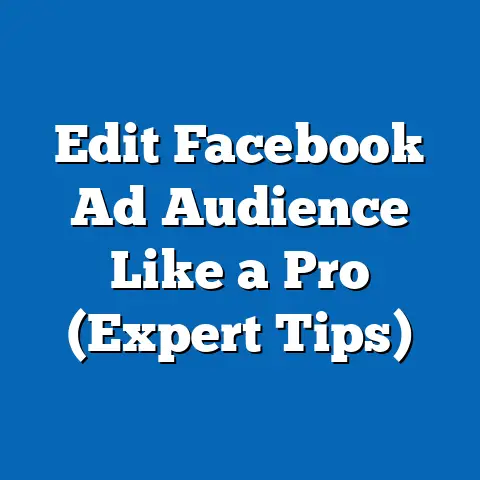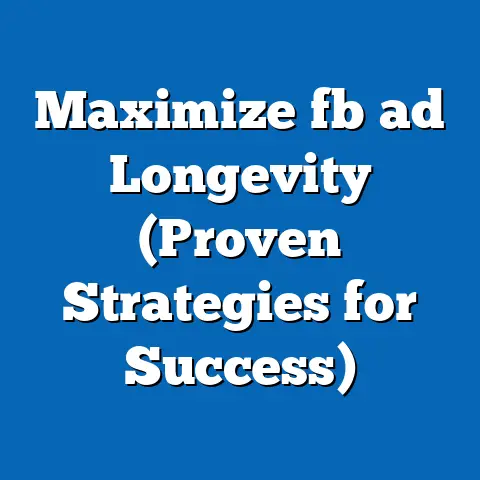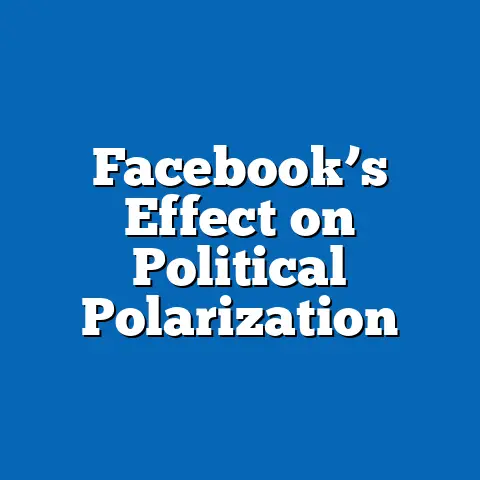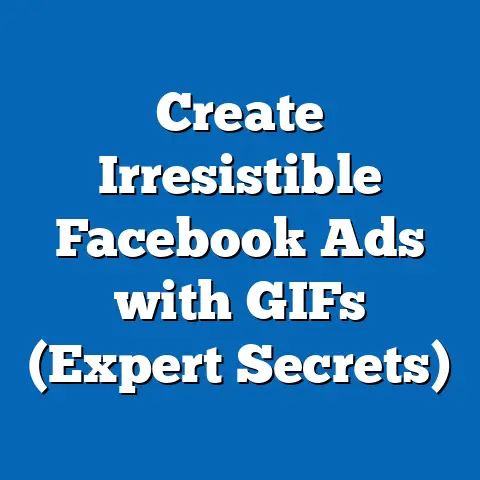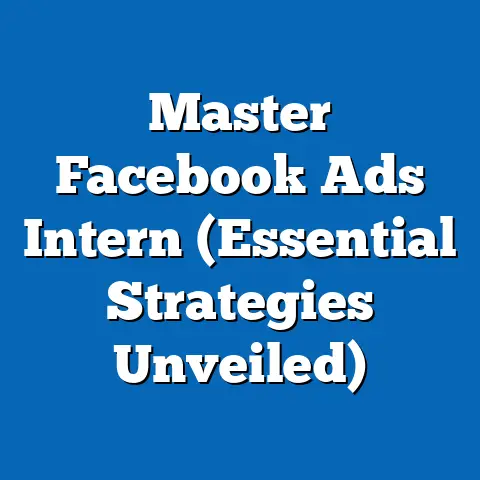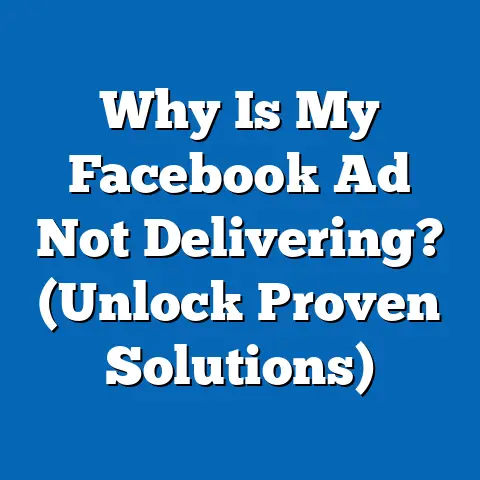Maximize Facebook Ad Results (Expert Group Strategies)
Maximize Facebook Ad Results: Expert Group Strategies
Facebook advertising. It’s a beast, isn’t it? I remember when I first started running ads, I felt like I was throwing money into a black hole. Clicks, impressions, reach – all these terms swirling around, but no real understanding of how to turn them into tangible results. But over the years, I’ve learned, experimented, and gleaned insights from some truly brilliant minds in the industry. And I’m going to share those insights with you.
We’re not just talking about the basics here. We’re going to delve deep into proven strategies, real-world examples, and actionable tips that you can implement today to significantly improve your Facebook ad performance.
Introduction
The digital marketing landscape is constantly evolving, and Facebook advertising is no exception. One of the most significant trends I’ve observed is the rise of personalized video content. Think about it: generic ads are easily ignored, but a personalized video that speaks directly to your needs? That’s a game-changer.
According to recent statistics, personalized video ads have a 6x higher engagement rate than traditional display ads. Moreover, Facebook’s algorithm increasingly favors video content, giving it more visibility in users’ news feeds. This means if you’re not leveraging video and personalization, you’re missing out on a massive opportunity.
Understanding this trend is vital for businesses aiming to stay competitive. In this crowded social media landscape, standing out requires more than just a catchy headline. It demands a deep understanding of your audience, creative ad content, and meticulous campaign optimization. That’s why I’m here to guide you through expert strategies that can help you maximize your Facebook ad results in light of these evolving dynamics.
1. Understanding the Facebook Advertising Landscape
Let’s start with a quick history lesson. Facebook advertising has come a long way since its inception. Initially, it was a simple platform for promoting pages and driving likes. Now, it’s a sophisticated ecosystem with advanced targeting options, diverse ad formats, and powerful analytics tools.
Today, Facebook boasts over 2.9 billion monthly active users, making it a goldmine for businesses looking to reach a wide and diverse audience. The platform offers a range of ad formats, including:
- Image Ads: Simple and effective for showcasing products or services.
- Video Ads: Highly engaging and perfect for storytelling.
- Carousel Ads: Allow you to display multiple images or videos in a single ad unit.
- Collection Ads: Designed for e-commerce, showcasing products in a visually appealing format.
- Instant Experience Ads: Full-screen, immersive ads that load instantly.
Facebook also provides essential tools like the Facebook Pixel, which tracks website conversions and allows for retargeting, and Ads Manager, the central hub for creating and managing campaigns.
But here’s the thing: everyone else is trying to tap into this goldmine too. The competition on Facebook is fierce. Standing out requires more than just a basic understanding of the platform. It demands a deep understanding of your audience, creative ad content, and meticulous campaign optimization. You need to be innovative, strategic, and always testing new approaches.
Takeaway: Facebook advertising is a powerful tool, but it’s a competitive landscape. Staying ahead requires continuous learning and adaptation.
2. These are the strategies that I’ve seen work, and that the experts swear by.
2.1 Audience Targeting
I can’t stress this enough: targeting is everything. You could have the most beautiful, compelling ad in the world, but if you’re showing it to the wrong people, it’s like shouting into the void.
Audience segmentation and targeting are the cornerstones of successful Facebook advertising. Gone are the days of broad, generic campaigns. To truly maximize your results, you need to drill down and identify your ideal customer.
Here are some advanced targeting techniques that I’ve found incredibly useful:
- Custom Audiences: These are audiences you create based on your existing data. You can upload customer lists, website traffic, or app activity to target people who have already interacted with your business. I’ve had tremendous success retargeting website visitors who abandoned their shopping carts. A simple “Did you forget something?” ad with a discount code can work wonders.
- Lookalike Audiences: This is where things get really interesting. Facebook uses your Custom Audiences as a seed to find people who share similar characteristics, interests, and behaviors. It’s like cloning your best customers! I once used a Lookalike Audience based on my top 1% of customers, and the results were astounding. The conversion rate was nearly double that of my regular targeting.
- Interest-Based Targeting: This allows you to target people based on their declared interests, hobbies, and pages they’ve liked. It’s a broader approach than Custom or Lookalike Audiences, but it can still be very effective. The key is to be specific. Instead of targeting “marketing,” try targeting “content marketing for small businesses” or “email marketing automation.”
Expert Insight: “The more specific you are with your targeting, the higher your chances of success,” says digital marketing guru Neil Patel. “Don’t be afraid to niche down and focus on a smaller, highly engaged audience.”
How to Research and Identify Your Target Audience:
- Analyze Your Existing Customer Data: Look for patterns in demographics, purchase history, and engagement behavior.
- Use Facebook Audience Insights: This tool provides valuable data about your target audience, including their interests, demographics, and behaviors.
- Conduct Surveys and Polls: Ask your customers directly about their preferences and pain points.
- Monitor Competitor Activity: See who your competitors are targeting and what strategies they’re using.
Takeaway: Invest time and effort in understanding your target audience. The more you know about them, the better you can target your ads and maximize your results.
2.2 Crafting Compelling Ad Content
Okay, you’ve got your targeting dialed in. Now it’s time to create ads that actually grab attention and drive action. This is where creativity and storytelling come into play.
The elements of high-performing ad copy and visuals are:
- A Clear and Concise Headline: You have mere seconds to capture someone’s attention. Make your headline punchy, intriguing, and relevant to your target audience.
- Compelling Body Copy: Tell a story, highlight the benefits of your product or service, and create a sense of urgency. Use strong verbs and avoid jargon.
- Eye-Catching Visuals: Use high-quality images or videos that are visually appealing and relevant to your message.
- A Strong Call-to-Action: Tell people what you want them to do. Use clear and concise calls to action like “Shop Now,” “Learn More,” or “Get a Free Quote.”
Storytelling and Emotional Engagement:
People don’t buy products; they buy solutions to their problems or aspirations. Your ads should tell a story that resonates with your target audience on an emotional level.
For example, instead of saying “Our software saves you time,” try saying “Imagine spending less time on tedious tasks and more time growing your business.”
Expert Tip: “People are more likely to remember stories than facts,” says marketing expert Seth Godin. “Use storytelling to connect with your audience on a deeper level and make your ads more memorable.”
Designing Eye-Catching Ads:
- Use High-Quality Images and Videos: Avoid blurry or pixelated visuals.
- Use Bright Colors and Bold Fonts: Make your ads stand out from the crowd.
- Use Visual Hierarchy: Guide the viewer’s eye to the most important elements of your ad.
- Keep it Simple: Avoid clutter and focus on a clear message.
A/B Testing:
A/B testing is the process of testing different versions of your ads to see which performs best. This is crucial for optimizing your ad content and improving performance.
Test different headlines, body copy, visuals, and calls to action. Use Facebook’s A/B testing feature to easily compare different versions of your ads.
Takeaway: Create ads that are visually appealing, emotionally engaging, and relevant to your target audience. Use A/B testing to continuously optimize your ad content and improve performance.
2.3 Optimizing Ad Campaigns
You’ve got your targeting dialed in, and your ads are looking great. But the job’s not done yet. You need to continuously monitor your ad performance and optimize your campaigns to maximize your ROI.
Monitoring Ad Performance:
Key metrics to track:
- Click-Through Rate (CTR): The percentage of people who see your ad and click on it.
- Cost Per Click (CPC): The amount you pay each time someone clicks on your ad.
- Conversion Rate: The percentage of people who click on your ad and take a desired action, such as making a purchase or filling out a form.
- Return on Ad Spend (ROAS): The amount of revenue you generate for every dollar you spend on advertising.
Strategies for Optimizing Ad Campaigns:
- Adjust Budget Allocation: Allocate more budget to your best-performing ads and less budget to your worst-performing ads.
- Refine Targeting Parameters: Adjust your targeting parameters based on performance data. For example, if you’re seeing high CTRs from a specific age group or location, focus your targeting on those demographics.
- Pause Underperforming Ads: Don’t be afraid to pause ads that aren’t performing well. It’s better to cut your losses and focus on what’s working.
- Experiment with Different Ad Formats: Try different ad formats, such as video ads or carousel ads, to see which resonates best with your audience.
Leveraging Facebook’s Algorithm:
Facebook’s algorithm is constantly learning and adapting. The more data you feed it, the better it becomes at optimizing your ads for performance.
- Use Conversion Tracking: Install the Facebook Pixel on your website to track conversions and feed data back to the algorithm.
- Use Automatic Bidding: Let Facebook automatically adjust your bids to maximize your results.
- Use Campaign Budget Optimization (CBO): Let Facebook automatically allocate your budget across your ad sets to maximize your overall campaign performance.
Expert Insight: “Facebook’s algorithm is your friend,” says digital marketing expert Amy Porterfield. “The more you leverage it, the better your results will be.”
Takeaway: Continuously monitor your ad performance and optimize your campaigns based on data. Leverage Facebook’s algorithm to automate and improve your results.
3. Case Studies and Success Stories
Let’s look at some real-world examples of businesses that have successfully implemented these expert strategies.
Case Study 1: E-commerce Brand
An e-commerce brand selling handmade jewelry implemented a strategy focused on personalized video ads and Lookalike Audiences. They created a series of short videos showcasing their jewelry and targeting customers with personalized messages based on their past purchases. They also created Lookalike Audiences based on their top customers.
The results were impressive:
- 3x increase in conversion rate
- 50% decrease in cost per acquisition
- 2x increase in ROAS
Case Study 2: Local Restaurant
A local restaurant used targeted ads to promote their new menu items and drive reservations. They created Custom Audiences based on people who had visited their website or engaged with their Facebook page. They also used interest-based targeting to reach people who were interested in food and dining in their local area.
The results were:
- 25% increase in reservations
- 15% increase in revenue
- Positive feedback from customers who saw the ads
Lessons Learned:
- Personalization is key. Tailor your ads to your target audience and create a sense of connection.
- Lookalike Audiences can be incredibly powerful. Use them to reach new customers who are similar to your best customers.
- Targeting local audiences can be highly effective. Use location-based targeting to reach people in your local area.
Conclusion
I’ve covered a lot of ground here. From understanding the Facebook advertising landscape to implementing expert strategies for audience targeting, ad content, and campaign optimization. I’ve also shared real-world case studies that demonstrate the power of these strategies.
The key takeaway is this: Facebook advertising is not a set-it-and-forget-it endeavor. It requires continuous learning, experimentation, and adaptation. You need to stay on top of industry trends, test new approaches, and continuously optimize your campaigns based on data.
I encourage you to take a proactive approach in implementing these expert strategies. Start by analyzing your existing campaigns and identifying areas for improvement. Then, experiment with different targeting techniques, ad content, and optimization strategies.
The potential of Facebook ads is immense. When executed effectively, it can drive significant results for your business. So, embrace the challenge, stay curious, and never stop learning. The world of Facebook advertising is constantly evolving, and the opportunities are endless. Keep testing, keep learning, and keep adapting.

